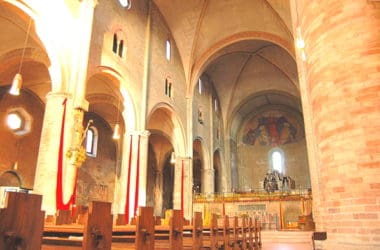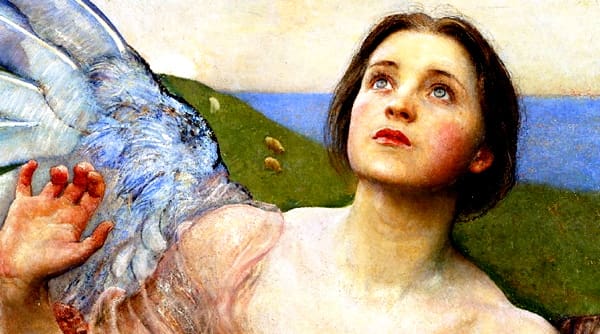Christian prayer is a true conversation with God. This holy dialogue is based on a real relationship between the Giver of all good gifts and the one who offers sacrifice, between the Protector and the one who seeks His will. Both the similarity and difference of the human person to God together create the boundaries for this relationship.
Above the horizon of creation, the Creator draws His work to Himself. The Trinity, who is a multiplicity of eternal relations in unity, draws into unity the multiplicity of temporal relations in creation. The closer the Word draws creation to the Father, the more complete and beautiful it becomes.
Awe over passing wonders disposes the heart to awe over wonders that do not pass. The Word of the Father raises up into divine harmony things that are visible in this world below: duration, extension, light, mass, and all kinds of mysterious forces like gravity, magnetism, atomic, electricity are bound together in tensions both primordial and eschatological, completed and not yet, present but not fully so. Over all this visible, observable, measurable cosmos, something invisible constantly draws it into existence and propels it to something beyond its own finitude – so that its own visible beauty is a fleeting sign of a spiritual beauty.
The more creation resonates with the eternal harmony of this Word, the more the Father rejoices in the Holy Spirit that His work is different, totally other than Himself. The Father contemplates in creation’s very otherness the inexhaustible fullness of the unity of the Holy Spirit through, with and in His only Begotten Son. In other words, He sees that His work is good, so very good that He blesses creation with His Divine Presence. Thus, His work of creation is where God discloses Himself and where His blessing is received.
Over all His work, the human person, each individual man and woman, is the particular object of the Holy Trinity’s inexhaustible love. The Father’s love draws all people together into the mysterious boundary where humanity and divinity touch. It is a garden enclosed by painful differences and delicate similarities fashioned together in the very person of His only begotten Son. This boundary, the Creator permits to exist between Himself and creation, is the spiritual space in which those sons and daughters, adopted into Christ’s Sonship, can dare to approach His Heavenly Father.
What is this spiritual space where Creatures participate in the unending and superabundant circumcession of filial and paternal love? Although more difficult to discern in some contemporary liturgical  environments, ancient and medieval Church architecture celebrate this paradise, this enclosed garden, this sanctuary. Carved in wood and stone, adorned with columns and arches and stained glass, the whole spiritual drama of the Trinity’s love for humanity (and for each soul) unfolds as one approaches the altar, the very heart of these churches, the symbol of Christ in the Universe and in the soul.
environments, ancient and medieval Church architecture celebrate this paradise, this enclosed garden, this sanctuary. Carved in wood and stone, adorned with columns and arches and stained glass, the whole spiritual drama of the Trinity’s love for humanity (and for each soul) unfolds as one approaches the altar, the very heart of these churches, the symbol of Christ in the Universe and in the soul.
One enters such a place of worship more by prayer than by physical awareness of art and architecture. Only within that holy sanctuary, enclosed by the tender horizons in the heart, does humanity find the freedom to enter into a true relation with God, the integrity of a frail creature being protected before the absolute transcendence of the One who made Him.
 In the heart at prayer, there are boundaries placed, not as obstacles, but instead for a holy relationship with One whom we are not worthy to approach but who has called us all the same. Thus, we remember our sinfulness and plead for the Father’s mercy, trusting more in divine mercy than in our frailty. Such a soul who knows this gift of holy fear can come to discern the divine whisper that calls,
In the heart at prayer, there are boundaries placed, not as obstacles, but instead for a holy relationship with One whom we are not worthy to approach but who has called us all the same. Thus, we remember our sinfulness and plead for the Father’s mercy, trusting more in divine mercy than in our frailty. Such a soul who knows this gift of holy fear can come to discern the divine whisper that calls,
“Come, thou blessed of my Father.”
Grace, the gift of participating in the Trinity’s life of love and truth, is the source of likeness and communion. To be raised into and enjoy a graced relation with the eternal relations of the Holy Trinity, this is the greatness of the human vocation. This mysticism of relationship and communion is not merely a future idea to which we aspire. It is a mysticism of relation we can already know in this present moment through the blood of Christ poured out for us.
This mysticism of relationship does not confuse or co-mingle a creature’s identity with the Creator, but deepens and makes each individual personality a more unique and un-repeatable expression of divine image and likeness. This is why the divine conversation that Christians enter into does not involve the surmounting, suppressing or overcoming of frail humanity. Instead, the prayer of faith is a source of healing, a restoration of personal integrity, a purification from all that mars and weighs down humanity, a freedom from self-occupation and self-deception, a radical self-emptying in humility, an elevation above the evils that try to define one’s existence, a participation in that higher, supernatural life in love and truth that is the source and summit of all creation.
Editor’s Note: For more from Dr. Lilles, see his books: “Hidden Mountain, Secret Garden: A Theological Contemplation on Prayer” and “Fire from Above”. He also collaborated with Dan Burke on “30 Days with Teresa of Avila” and “Living the Mystery of Merciful Love: 30 Days with Thérèse of Lisieux”.
+
Art for this post on Christian prayer: Interno del Duomo di Lodi, own work, Zuffe, 22 January 2009, PD-Worldwide; mirror detail of Sense of Sight, Annie Swynnerton, 1898, PD-US author’s life plus 70 years or less; both Wikimedia Commons.





